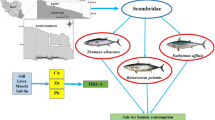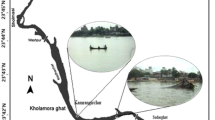Abstract
Contamination with heavy metals in wild red swamp crayfish (Procambarus clarkii) from 7 different geographical areas in six provinces of China (Hubei, Hunan, Jiangxi, Anhui, Jiangsu, and Shandong) was evaluated. Concentrations of chromium (Cr), arsenic (As), lead (Pb), cadmium (Cd), and mercury (Hg) in the abdominal muscle, gonad, and hepatopancreas were determined by inductively coupled plasma mass spectrometry (ICP-MS) and atomic fluorescence spectrometer (AFS). Except for the Cd content in the hepatopancreas, the contents of selected heavy metals in three different tissues were significantly lower than the proposed limits provided by United States Environmental Protection Agency (USEPA). The maximum accumulations of Cd and Pb were in the hepatopancreas, while the maximum accumulation of As was in the gonad, and the maximum accumulations of Hg and Cr were in the abdominal muscle. The highest contents of Cr, Hg, and Pb were all detected in Dongting Lake, Hunan, which was consistent with the trend of the metal pollution index (MPI). Risk value of the target hazard quotient (THQ) was below 1.0, suggesting that the intake of selected heavy metals through crayfish consumption would not pose a significant health risk to consumers.




Similar content being viewed by others
Data availability
Data and material access are not available.
References
Alcorlo P, Otero M, Crehuet M, Baltanás A, Montes C (2006) The use of the red swamp crayfish (Procambarus clarkii, Girard) as indicator of the bioavailability of heavy metals in environmental monitoring in the River Guadiamar (SW, Spain). Sci Total Environ 366(1):380–390
Ashraf W (2005) Accumulation of heavy metals in kidney and heart tissues of Epinephelus microdon fish from the Arabian Gulf. Environ Monit Assess 101(1–3):311–316
Beaumont JJ, Sedman RM, Reynolds SD, Sherman CD, Li LH, Howd RA, Sandy MS, Zeise L, Alexeeff GV (2008) Cancer mortality in a Chinese population exposed to hexavalent chromium in drinking water. Epidemiology 19(1):12–23
Beckers F, Rinklebe J (2017) Cycling of mercury in the environment: sources, fate, and human health implications: a review. Crit Rev Environ Sci Technol 47(9):693–794
Bollinger JE, Bundy K, Anderson MB, Millet L, Preslan JE, Jolibois L, George WJ (1997) Bioaccumulation of chromium in red swamp crayfish (Procambarus clarkii). J Hazard Mater 54(1–2):1–13
Chavez-Crooker P, Pozo P, Castro H, Dice MS, Boutet I, Tanguy A, Moraga D, Ahearn GA (2003) Cellular localization of calcium, heavy metals, and metallothionein in lobster (Homarus americanus) hepatopancreas. Comp Biochem Physiol C 136(3):213–224
Chi QQ, Zhu GW, Langdon A (2007) Bioaccumulation of heavy metals in fishes from Taihu Lake, China. J Environ Sci 19(12):1500–1504
Demayo A, Taylor MC, Taylor KW, Hodson PV, Hammond PB (1982) Toxic effects of lead and lead compounds on human health, aquatic life, wildlife plants, and livestock. Crit Rev Environ Sci Technol 12(4):257–305
DesMarais TL, Costa M (2019) Mechanisms of chromium-induced toxicity. Curr Opin Toxicol 14:1–7
Enterline PE, Henderson VL, Marsh GM (1987) Exposure to arsenic and respiratory cancer a reanalysis. Am J Epidemiol 125(6):929–938
Godt J, Scheidig F, Grosse-Siestrup C, Esche V, Brandenburg P, Reich A, Groneberg DA (2006) The toxicity of cadmium and resulting hazards for human health. J Occup Med Toxicol 1(1):22
Goldstein RM, Brigham ME, Stauffer JC (1996) Comparison of mercury concentrations in liver, muscle, whole bodies, and composites of fish from the Red River of the North. Can J Fish Aquat Sci 53(2):244–252
Harada M (1995) Minamata disease: Methylmercury poisoning in japan caused by environmental pollution. Crit Rev Toxicol 25(1):1–24
Hu C, Deng ZM, **e YH, Chen XS, Li F (2015) The risk assessment of sediment heavy metal pollution in the East Dongting Lake Wetland. J Chemother 2015:1–8
Huang Y, Chen Q, Deng M, Japenga J, Li T, Yang X, He Z (2018) Heavy metal pollution and health risk assessment of agricultural soils in a typical peri-urban area in southeast China. J Environ Manag 207:159–168
Jaishankar M, Tseten T, Anbalagan N, Mathew BB, Beeregowda KN (2014) Toxicity, mechanism and health effects of some heavy metals. Interdiscip Toxicol 7(2):60–72
Jia Y, Wang L, Qu Z, Wang C, Yang Z (2017) Effects on heavy metal accumulation in freshwater fishes: species, tissues, and sizes. Environ Sci Pollut R 24(10):9379–9386
Jiang X, Wang W, Wang S, Zhang B, Hu J (2012) Initial identification of heavy metals contamination in Taihu Lake, a eutrophic lake in China. J Environ Sci 24(9):1539–1548
Kouba A, Buřič M, Kozák P (2010) Bioaccumulation and effects of heavy metals in crayfish: a review. Water Air Soil Pollut 211(1-4):5–16
Kuklina I, Kouba A, Buřič M, Horká I, Ďuriš Z, Kozák P (2014) Accumulation of heavy metals in crayfish and fish from selected Czech reservoirs. Biomed Res Int 2014:1–9
Li F, Huang JH, Zeng GM, Yuan XZ (2013) Spatial risk assessment and sources identification of heavy metals in surface sediments from the Dongting Lake, Middle China. J Geochem Explor 132:75–83
Mitra P, Sharma S, Purohit P, Sharma P (2017) Clinical and molecular aspects of lead toxicity: An update. Crit Rev Cl Lab Sci 54(7–8):506–528
Mo AJ, Wang JH, Yuan MR, Zhao DX, Gu ZM, Liu Y, Huang HY, Yuan YC (2019) Effect of sub-chronic dietary L-selenomethionine exposure on reproductive performance of Red Swamp Crayfish. (Procambarus clarkii) Environ Pollut 253:749–758
Monikh FA, Safahieh A, Savari A, Ronagh MT, Doraghi A (2013) The relationship between heavy metal (Cd, Co, Cu, Ni and Pb) levels and the size of benthic, benthopelagic and pelagic fish species, Persian Gulf. B Environ Contam Tox 90(6):691–696
Mu F, Cheng Y, Wu X (2007) Distribution and industrial development of crayfish in the world. J Shanghai Fish Univ 16(1):64–72 (in Chinese)
Okati N, Moghadam MS, Einollahipeer F (2021) Mercury, arsenic and selenium concentrations in marine fish species from the Oman Sea, Iran, and health risk assessment. Toxicol Environ Heal Sci 13:25–36
Peng Q, Greenfield BK, Dang F, Zhong H (2016a) Human exposure to methylmercury from crayfish (Procambarus clarkii) in China. Environ Geochem Hlth 38(1):169–181
Peng Q, Nunes LM, Greenfield BK, Dang F, Zhong H (2016b) Are Chinese consumers at risk due to exposure to metals in crayfish? A bioaccessibility-adjusted probabilistic risk assessment. Environ Int 88:261–268
Ploetz DM, Fitts BE, Rice TM (2007) Differential accumulation of heavy metals in muscle and liver of a marine fish, (King Mackerel, Scomberomorus cavalla Cuvier) from the Northern Gulf of Mexico, USA. B Environ Contam Tox 78(2):134–137
Qin YW, Zhang L, Zheng BH, Cao W (2012) Speciation and pollution characteristics of heavy metals in the sediment of Taihu Lake. Environ Sci 33(12):4291–4299 (in Chinese)
Rahimzadeh MR, Rahimzadeh MR, Kazemi S, Moghadamnia AA (2017) Cadmium toxicity and treatment: an update. Caspian J Intern Med 8(3):135
Ratnaike RN (2003) Acute and chronic arsenic toxicity. Postgrad Med J 79(933):391–396
Roldan BM, Shivers RR (1987) The uptake and storage of iron and lead in cells of the crayfish (Orconectes propinquus) hepatopancreas and antennal gland. Comp Biochem Physiol C 86(1):201–214
Smith AH, Steinmaus CM (2009) Health effects of arsenic and chromium in drinking water: recent human findings. Annu Rev Public Health 30:107–122
Stinson MD, Eaton DL (1983) Concentrations of lead, cadmium, mercury, and copper in the crayfish (Pacifasticus leniusculus) obtained from a lake receiving urban runoff. Arch Environ Contam Toxicol 12(6):693–699
Suami RB, Sivalingam P, Kabala CD, Otamonga JP, Mulaji CK, Mpiana PT, Poté J (2018) Concentration of heavy metals in edible fishes from Atlantic Coast of Muanda, Democratic Republic of the Congo. J Food Compos Anal 73:1–9
Tang W, Shan B, Zhang H, Mao Z (2010) Heavy metal sources and associated risk in response to agricultural intensification in the estuarine sediments of Chaohu Lake Valley, East China. J Hazard Mater 176(1-3):945–951
US EPA (1989) Guidance Manual for Assessing Human Health Risks from Chemically Contaminated, Fish and Shellfish EPA–503/8–89–002. US Environmental Protection Agency (USEPA), Washington DC
US EPA (2019) United States Environmental Protection Agency. Table, Regional Screening Level (RSL) Summary
US FDA (1993) Guidance Documents for Trace Elements in Seafood, Center for Food Safety and Applied Nutrition. Washington, DC
Usero J, Gonzalez-Regalago E, Gracia I (1997) Trace metals in the bivalve molluscs Ruditapes decussatus and Ruditapes philippinarum from the Atlantic coast of southern Spain. Environ Int 23:291–298
Wang W, Gu W, Ding Z, Ren Y, Chen J, Hou Y (2005) A novel Spiroplasma pathogen causing systemic infection in the crayfish Procambarus clarkii (Crustacea: Decapod), in China. FEMS Microbiol Lett 249(1):131–137
Wei Y, Zhang J, Zhang D, Tu T, Luo L (2014) Metal concentrations in various fish organs of different fish species from Poyang Lake, China. Ecotox Environ Safe 104:182–188
Wu C, Liu H, Fang Y, Lu D, **ng Z, Yuan W, Duan S, Qin L (2010) Survey on the content and intake of lead and cadmium in crayfish from market in Shanghai. J Environ Occup Med 27(11):650–656 (in Chinese)
**ong B, Xu T, Li RP, Johnson D, Ren D, Liu HG, ** Y, Huang YP (2020) Heavy metal accumulation and health risk assessment of crayfish collected from cultivated and uncultivated ponds in the Middle Reach of Yangtze River. Sci Total Environ 739:139963
Yang Z, Wang Y, Shen Z, Niu J, Tang Z (2009) Distribution and speciation of heavy metals in sediments from the mainstream, tributaries, and lakes of the Yangtze River catchment of Wuhan, China. J Hazard Mater 166(2-3):1186–1194
Yi Y, Yang Z, Zhang S (2011) Ecological risk assessment of heavy metals in sediment and human health risk assessment of heavy metals in fishes in the middle and lower reaches of the Yangtze River basin. Environ Pollut 159(10):2575–2585
Yi SK, Li YH, Shi LL, Zhang L, Li QB, Chen J (2018) Characterization of population genetic structure of red swamp crayfish, Procambarus clarkii, in China. Sci Rep 8(1):1–11
Yuan GL, Liu C, Chen L, Yang Z (2011) Inputting history of heavy metals into the inland lake recorded in sediment profiles: Poyang Lake in China. J Hazard Mater 185(1):336–345
Zahir F, Rizwi SJ, Haq SK, Khan RH (2005) Low dose mercury toxicity and human health. Environ Toxicol Pharmacol 20(2):351–360
Zhang D, Wei Y, Zhang L, Luo L, Chen Y, Tu T (2012) Distribution of heavy metals in water, suspended particulate matter and sediment of Poyang Lake, China. Fresenius Environ Bull 21(7a):1910–1919
Zhang YZ, Zhang MQ, Wu Y, Wu GH (2014) Biological accumulation and release of Cd and Cu in Procambarus clarkii. Food Sci 35(17):250–254
Funding
This work was supported by the National Natural Science Foundation of China (31770553) and the Fundamental Research Funds for the Central Universities (2662019FW008).
Author information
Authors and Affiliations
Contributions
Jianghua Wang: conceptualization, methodology, project administration, writing—review and editing, and funding acquisition. Yongchao Yuan: conceptualization, writing—original draft, supervision, and conceptualization. Aijie Mo: performing—experiment, writing—original draft, and methodology. Yangyang Huang: performing—experiment and writing—original draft. Zemao Gu: methodology. Chunsheng Liu: format analysis.
Corresponding authors
Ethics declarations
Ethical approval and consent to participate
Not applicable.
Consent for publication
Not applicable.
Competing interests
The authors declare no competing interests.
Additional information
Responsible Editor: Philippe Garrigues
Publisher’s note
Springer Nature remains neutral with regard to jurisdictional claims in published maps and institutional affiliations.
Rights and permissions
About this article
Cite this article
Mo, ., Huang, Y., Gu, Z. et al. Health risk assessment and bioaccumulation of heavy metals in Procambarus clarkii from six provinces of China. Environ Sci Pollut Res 29, 2539–2546 (2022). https://doi.org/10.1007/s11356-021-15855-6
Received:
Accepted:
Published:
Issue Date:
DOI: https://doi.org/10.1007/s11356-021-15855-6




